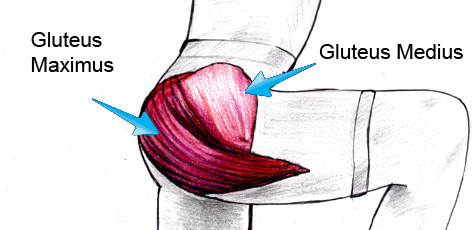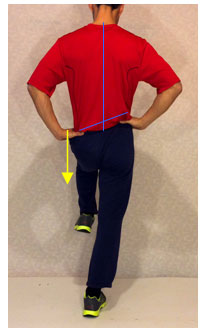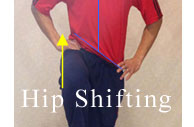How You Can Relieve Glute Muscle Pain
By Sherwin Nicholson | May 4, 2020
Did you know that your gluteus muscles are not only just important for your hips but also your back? It’s not your back muscles that need conditioning as much as it’s your glutes.
If you are finding that you are having chronic, dull or sensitive sensations of pain on the sides of your hips, then it’s most likely those troublesome muscles.
Glute muscle pain is the muscular discomfort that you experience in the rear and sides of your buttock.
When they stop moving and become weaker, you will have problems. But fortunately, there is a natural way to fix it.
What you should know first, so you can self-treat yourself
This muscle group consist of the minimus, medius and maximus.
The gluteus minimus is located underneath the medius. Together with the medius, their role is to abduct the hip and to prevent adduction.
This movement is what rotates your thigh inward. It is the action of raising your thigh up in front of you and turning your foot outward. It is also the action made if you were to try to point your knees towards each other.
The other function is to stabilize the hip joint and to provide support while standing on one leg.

A weakness in these will affect your hip joint, walking gait, pelvic tilt and stability, balance, etc. If untreated, it will lead to hip, lower back and knee issues.
Note: If you have a desk job or must spend a lot of your time driving or sitting for a living, you are bound to be sore. When you sit at your job, all of your glutes have deactivated and their circulation is restricted. With the lack of movement during work, you end up with sore hips that really begin to cause discomfort whenever you need to use them.
Note: Be sure to check if your pain is from your piriformis muscle. It can also cause similar symptoms.
A Simple Test for Weak Glutes
A simple test for weakness is first to stand up straight and place both hands on each hip. Then bend one knee as if to raise your foot slightly off of the ground.
If your suspended side drops slightly to the floor, you have  weakness and weakness and pelvic instability. You will notice this more as the hand on the suspended hip lowers below the level of the other hand.
weakness and weakness and pelvic instability. You will notice this more as the hand on the suspended hip lowers below the level of the other hand.
Please note: You can have the opposite problem where your glutes have become so tight and stiff that your hip does not drop but it remains fixed. Try moving your hips up and down. If it is very difficult to do, your hips are both weak and tight. This tightness also causes it to hurt.
The role of the gluteus maximus is to rotate the thigh and leg externally and also to extend it. This is the primary muscle to raise you up from a sitting position and also to lower you.
If your gluteus maximus is weak, you will find it difficult to perform many activities that involve bending at the hip while you are supporting your body weight. Your knees and lower back will compensate for this along with the thigh. Any combination of these other muscle groups will fatigue over time leading to lower back and knees issues.
A sedentary lifestyle significantly contributes to weak gluteal muscles.
Most people will assume that treatment directly for the back muscles and knees are required when it is the hip muscles that are the primary source of dysfunction.
A very helpful and effective exercise for weak glutes is the Standing Hip Shift. This shift combines stretching, strengthening and stabilizing and is great for helping to relieve morning stiffness.
For those with limitations with lower back pain, this exercise can be challenging. If you find it difficult to perform this, then this is an indication of the weaknesses of your hips. Weak hips lead to a very sore back.
Learn Hip Shifting
This simple movement requires the practice of Hip Shifting. Hip shifting aids in the release in very tight, weak lower back and hip muscles. It improves hip mobility and balance.
Those of us with pain have very limited mobility in these areas of the hip and back. It almost feels as if you are locked or frozen in this region of your body. To hip shift is NOT easy but it helps to counteract muscle guarding.
Guarding is necessary when the body tries to immobilize a specific area of the body to prevent further injury to another. This often happens to people with lower back pain. A person with a history of experiencing several episodes of lumbar disc pain (including back spasms) will have muscle guarding issues.
As their pain subsides or becomes more manageable, the muscles that have ‘locked’ can limit movement,
remain tight and stiff. 
Locking prevents the healthy and correct motion of your hips. Hip Shifting helps you to retrain your body to release this tension. It releases pressure and stiffness and gives you relief.
If you suffer from lower back pain and find the Standing Knee to Chest difficult to master or perhaps tiring, then you will need to retrain and recondition these muscles prior to performing this movement with a different level of exercises. These helpful preconditioning exercises are available on this site.
All of the movements and stretches required can be found in the program. This includes many specific and targeted Hip Shifting methods required to relieve pain. It is a safe, comfortable and progressive set of exercises this gives your hips much-needed stability and strength. It will reduce pressure and discomfort on the knees and lower back.
If you’re in a lot of discomfort at work while at your desk, follow these 5 simple tips now to feel better.
References:
- Mobilization-Comparison between Specific Lumber Mobilization and Core-Stability Exercises in Mechanical lbp.-http://www.ncbi.nlm.nih.gov/pubmed/24639852
- Effects of stabilization exercises on health-related quality of life in women with chronic lbp.-http://www.ncbi.nlm.nih.gov/pubmed/24184617
- Predictors of response to exercise therapy for chronic lbp: result of a prospective study with one year follow-up. – Cecchi F(1), Pasquini G, Paperini A, Boni R, Castagnoli C, Pistritto S, Macchi C. 1. Eur J Phys Rehabil Med. 2014 Jan 16. [Epub ahead of print] PMID: 24429917 [PubMed – as supplied by publisher]
